People

Elizabeth (Betsy) R. Dumont - P.I.
My research program addresses the interactions among anatomy, behavior and ecology in the evolution of mammals. The earliest mammals were tiny, insect-eating creatures. From these unremarkable ancestors, the history of mammals is largely a story of diversifying in ways that allow them to exploit a wide array of food resources. The anatomy, behavior and ecology of feeding are integrally related and have interacted over evolutionary time to give rise to over 4,600 species of mammals we see today. The main goal of my research is to identify and understand patterns and processes surrounding these interactions. I accomplish this through two separate but complementary kinds of studies: those that document associations among anatomy, behavior, and ecology in the field, and those that harness tools from engineering to explore the underlying mechanisms that link them.
bdumont"at"bio.umass.edu CV
topPost-Docs
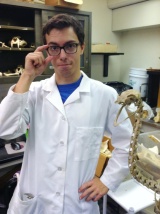
Brandon Hedrick - Postdoctoral Researcher
My research interests concern the evolution of shape change, comparative morphology, modularity, asymmetry, phylogenetic comparative methods, and morphological diversity in both fossil and modern lineages. Geometric morphometrics is a technique that can be used to quantitatively evaluate morphological changes between different taxa and the evolutionary history of those changes. Using this method, it is possible to answer a broad range of questions. For example: (1) how shape change occurs along a lineage, which allows for evaluation of functional morphology, (2) whether a group of animals has high integration (or lack thereof) between biologic structures, which relates to evolvability, and (3) how animals differ in their deviations from bilateral symmetry (random left-right asymmetry), which relates to canalization. My previous work has also encompassed taphonomy (the study of fossil burial), dinosaur taxonomy, dinosaurian bone histology, and the evolution of flight.
bphedrick1"at"gmail.edu CV
topGrad Students
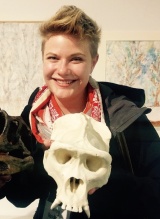
Abby Vander Linden - PhD Student
I am interested in the evolution of morphological diversity, and how different morphologies function in the context of an animal's environment. My current research is focused on the evolution of the neck in different groups of mammals. In particular, I'm interested in exploring how the shape of the cervical vertebrae has evolved in horned and antlered mammals such as sheep, goats, antelopes, and deer. Males of these species ram, stab, and wrestle each other using their horns and antlers as weapons, and fighting ability determines whether a male can successfully mate with females. I use a combination of 3D shape analysis, phylogenetic comparative methods, and biomechanical models to investigate how the neck vertebrae of these animals have evolved to resist forces from different fighting behaviors.
vanderlinden"at"bio.umass.edu CV

Andrew Smith - PhD Candidate
My research questions focus on morphological diversity and how it changes through time. More specifically, I use a range of computational, phylogenetic comparative, and physical modeling techniques, primarily using the mammalian feeding system, to explore the evolution of morphology in this group of animals. As homeothermic organisms, mammals need to process relatively large quantities of food to maintain their high metabolic rate. This has led to a number of complex adaptations involving the feeding system that comprises of specialized teeth and jaws. Mammalian teeth are very morphologically disparate and reflect the diverse range of dietary niches available to them. Similarly, mammalian jaws are also highly disparate reflecting their varied roles in feeding, but also in communication (i.e. mammal vocalizations), locomotion (i.e. mouth burrowing rodents), and sexual selection (i.e. elephant seals). My research focuses on how this morphological diversity was achieved, and is distributed over the mammalian tree.
ajsmith"at"bio.umass.edu CV Website

Yi-Fen Lin - PhD Candidate
My fascination to nature beauty and spots leads me in the study of biomechanics and functional morphology of biological systems—stunning artwork shaped by evolution. For my dissertation, I use moles (Talpidae) as a model system to study the evolution of burrowing. I ask 1) how the morphological specializations, especially the unique humeri and tendon-ligamentous system, promote the efficiency of this high energy-consuming locomotion and 2) how these changes consequently affect the digging behaviors and geographic distributions among different mole species. This study will begin to provide insights into the evolution of fossorial ecology in moles and, by extension, other mammals.
yifen"at"bio.umass.edu CV Website
topTechs / Undergrads
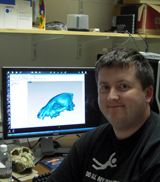
Dan Pulaski - Modelling Technician
I
come to the Dumont lab from the Information Technology/Services field.
Prior to joining the lab, I spent a number of years in the industry as
well as a year teaching at Franklin County Technical School. The
majority of my time in the lab involves acquiring CT Scans of
specimens, generating surface models from those scans and finally
creating solid meshes for FEA. This allows the researchers in the lab
to focus on research, as opposed to spending days/weeks in front of a
computer generating models.
pulski"at"gmail.com
topLab Alumni

Tom Eiting - PhD Student (2007-2014)
In general, my main interests lie in understanding the evolution of form and function in mammals. Bats make an excellent group to study the form-function relationship among mammals because they are species-rich and they are morphologically and ecologically diverse. In particular, I am interested in the morphology and functional demands of the nasal passages of bats. Like most other mammals, the bat nose serves important respiratory and olfactory functions. Unlike other mammals, however, several groups of bats also transmit high-frequency echolocation calls through their noses. This novel function likely has morphological and functional demands on the internal passages of the nose. Using anatomical data, computational fluid dynamics, and phylogenetic comparative methods, my research focuses on testing ideas regarding morphological optimization and functional trade-offs in the nasal passages of bats.
tom.eiting"at"utah.edu
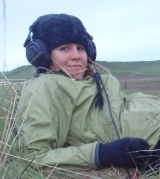
Nina Veselka - MS Student (2010-2013)
In general, I am interested in how trade-offs constrain phenotypic evolution, and how novel changes in morphology lead to species diversification. I am examining these ideas within New World leaf-nosed bats (phyllostomids), which exhibit the greatest dietary diversity of all living mammals. The ability to fly has limited how bats use their forelimbs for activities other than flight. The consumption of food is necessary for survival and many mammals use their arms and hands to collect and handle food items. For my thesis, I am investigating the manner in which phyllostomids use their wings, especially their thumbs, to manipulate food, and how this might affect their flight ability. Additionally, I am interested in examining the link between the evolution of frugivory and thumb size in phyllostomids, particularly if increased thumb size has led to speciation in this family.
nina.veselka"at"gmail.com

Julian Davis - Postdoctoral Researcher (2008-2010)
I received my Ph.D. in Engineering Mechanics from Virginia Tech in 2007. For my dissertation, I studied the connection between form and function of the utricle, an otoconia organ in the inner ear that contributes to one's sense of balance. Using a combination of finite element (FE) models constructed from confocal microscope images and typical engineering analysis techniques, I was able to uncover the effect of utricular structure on the mechanical response of this organ. This research sparked an interest and passion to explore the mechanics of biological structures. Using FE modeling in conjunction with modern imaging techniques and engineering analysis, I hope to contribute to the effort to answer questions on form, function and ecology through mechanics. Of particular interest to me are investigations pertaining to skull mechanics and the otoconia organs that make up the vestibular system.
jldavis2"at"usi.edu
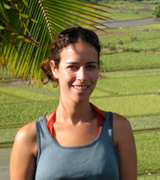
Jaime Tanner - Postdoctoral Researcher (2008-2009)
My main research interests lie in understanding the relationship between form and function in biological organisms in order to gain insight into the selective pressures that mold the ecology and evolution of species. In particular I am interested in the way that form/function relationships change throughout development. My research takes an integrative approach, combining behavioral, morphological and performance data to understand ontogenetic shifts in members of the Order Carnivora. My dissertation research focused on developmental changes in skull morphology and feeding behavior in the spotted hyena and, currently, we are seeking funding to investigate the effect of sociality on the link between fitness and performance in two members of the Family Herpestidae, meerkats and yellow mongoose.
jtanner"at"marlboro.edu Website
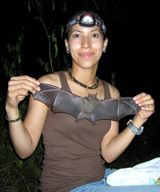
Sharlene Santana - PhD Student (2005-2010)
I am interested in understanding ecomorphological patterns and processes, in particular those surrounding adaptive radiations. For my dissertation research, I use Neotropical leaf-nosed bats (phyllostomids) as a model system to study the interplay among morphology, performance and behavior associated with the outstanding dietary diversification of these bats. My research integrates performance and behavior data gathered in the field with state of the art techniques for analyzing morphology and evolutionary patterns. With this approach, I expect to provide new insights into the evolution of ecological specialization in bats and, by extension, other mammals.
ssantana"at"uw.edu Website


